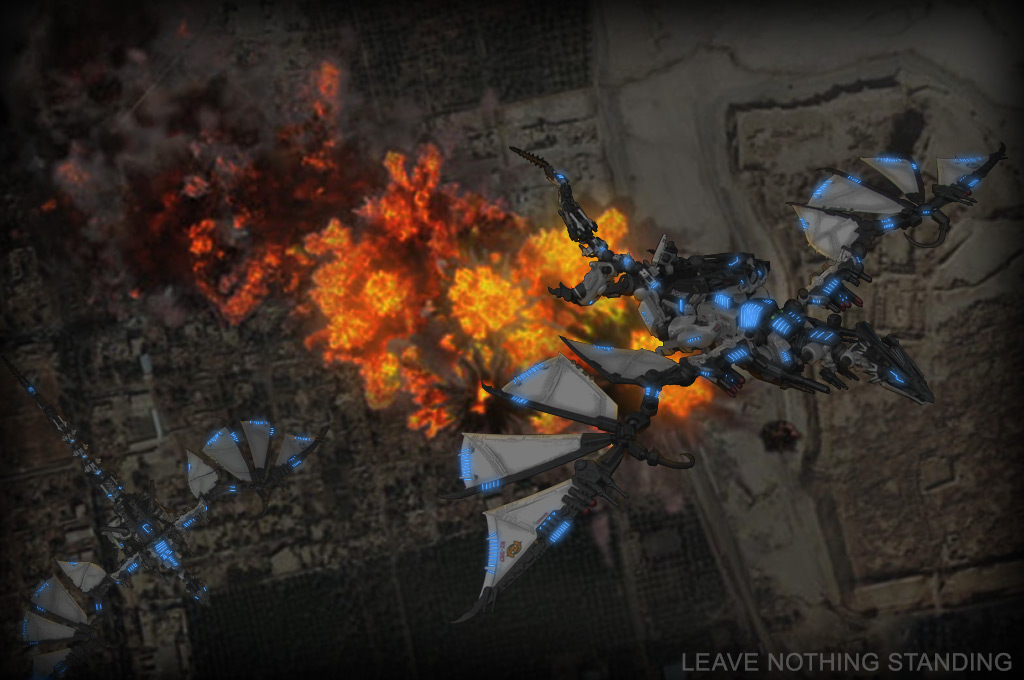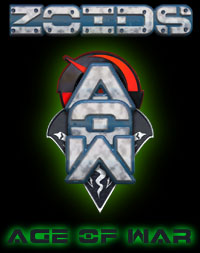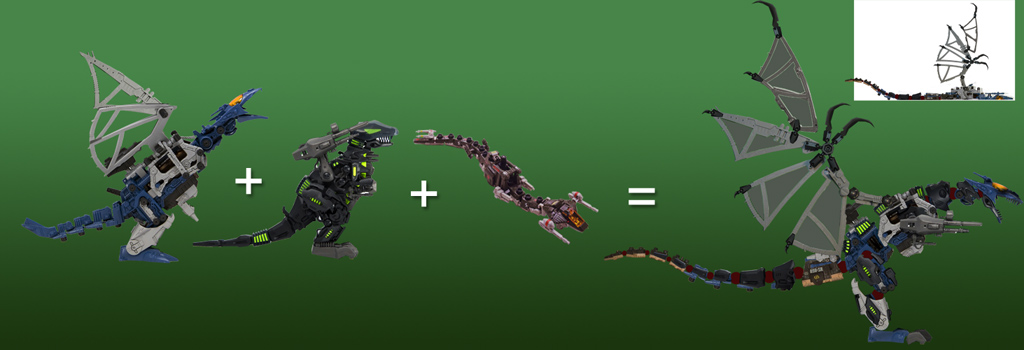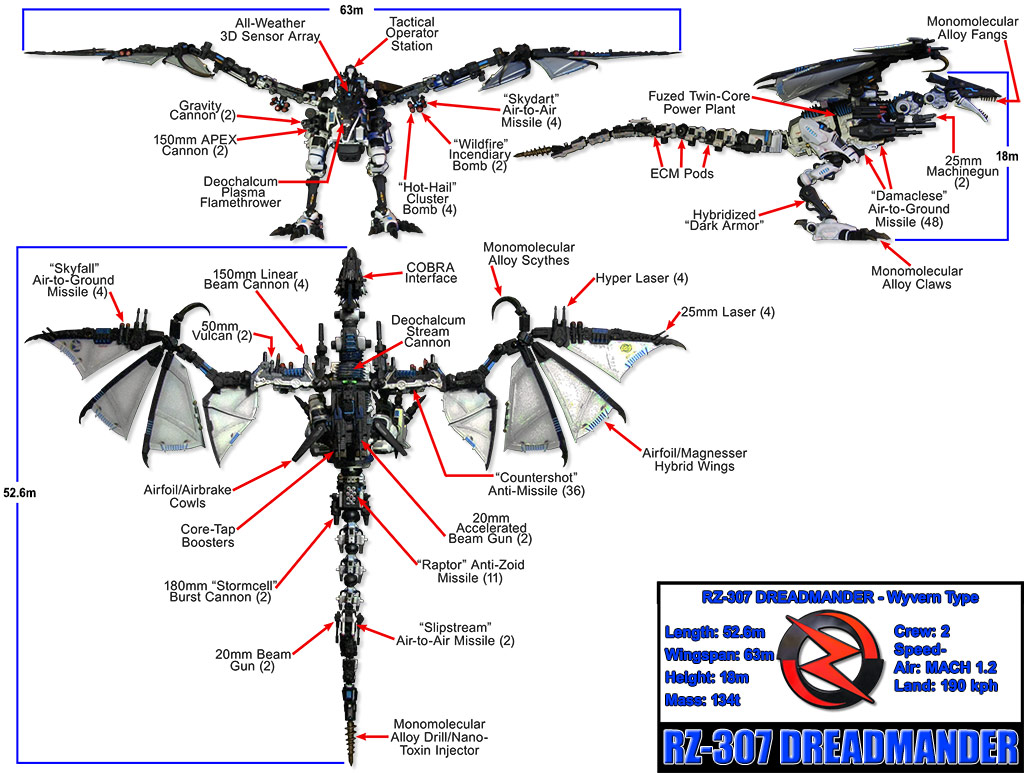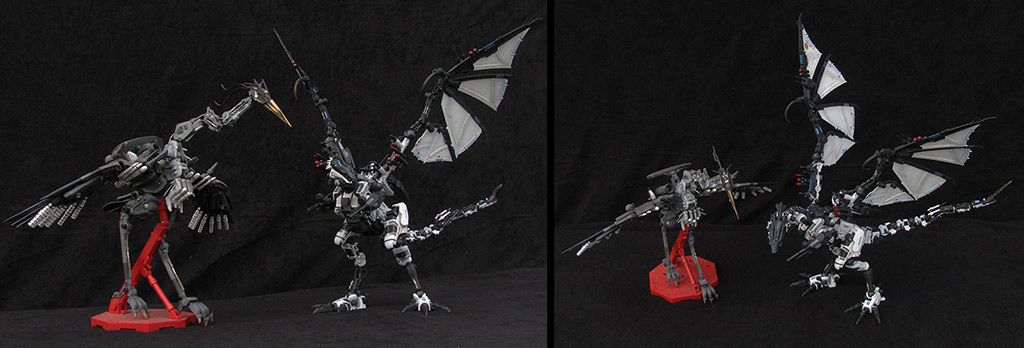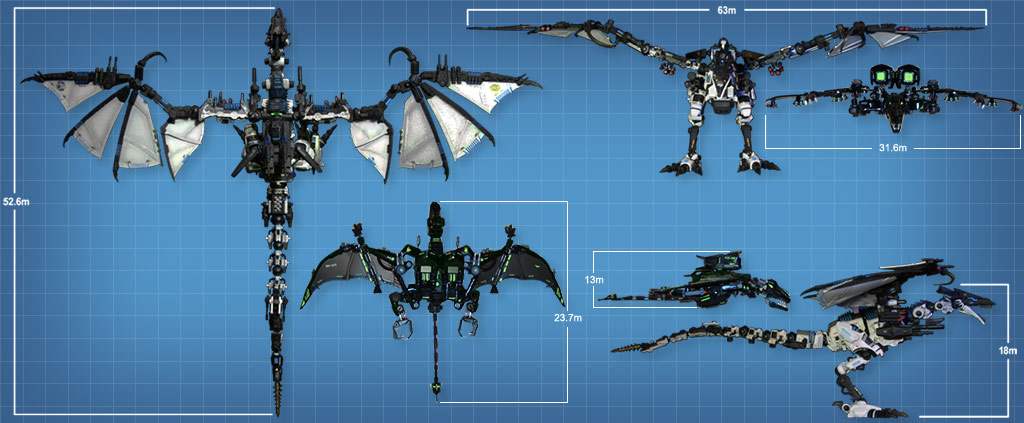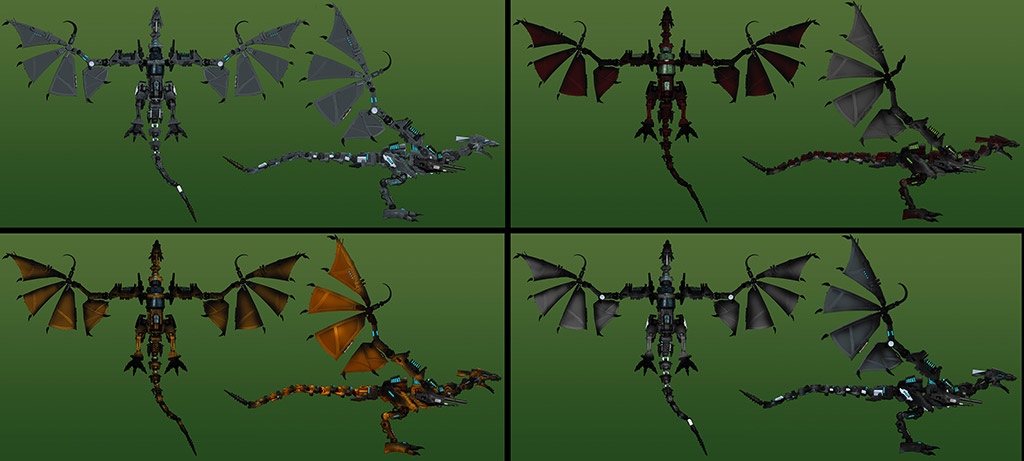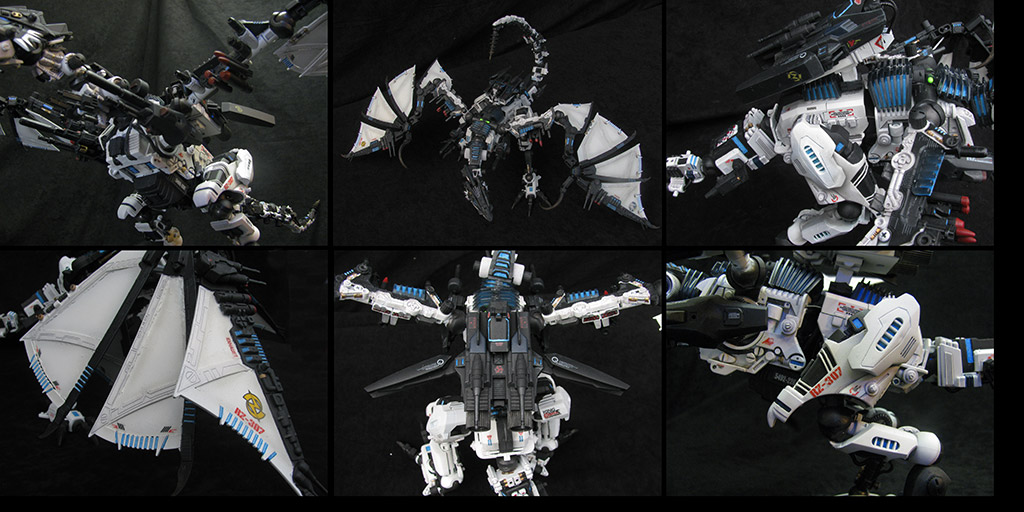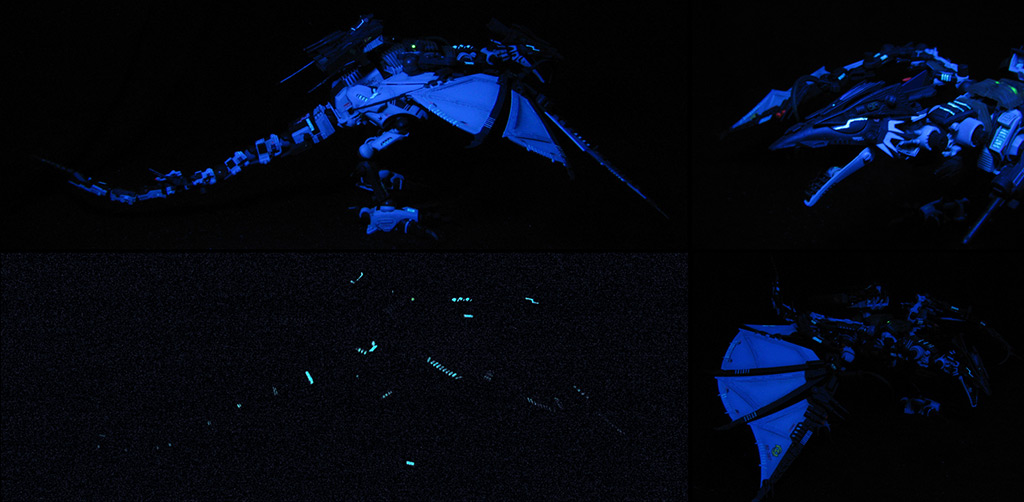THE NECK
Moving forward, once again it is time to take a couple of simple joints and replace them with an elaborate network of parts and some universal joints. I had to core the first neck piece so that I could fit the Struxx skeleton inside. The assembly fits like a glove (a well-shaved and glued glove), and it is held together with the Deadborder neck grill. I stuffed some voids with detail bits before moving on to the second segment. At this point, I was still considering adding some Deadborder armor to unify the look.
SECOND NECK PIECE
Honestly, I thought the smaller neck piece was going to be the harder of the two to make since it had less room inside and almost no margin for error. The opposite was true, to a degree. The Struxx component required more trimming and fitting, then was screwed together for strength, but the Radox pieces merely needed to have an opening sanded through the center. Once it came together, the neck was complete.
A BIGGER, BETTER TAIL
For the wyvern concept to actually work, visually, the tail had to be stretched. Along with greater length, the base segment had to be reworked; the Salamander tail base was little more than a thick "C" clip. I used the Snake's motor segment to fill in that base and ran some Struxx joints through it. The opening for the motor created a perfect box to fill with a rear gunner station or missile launcher, which was out choice.
WORKING AFT
As I continued to work toward the tail tip, each piece required different cuts despite using the same components. I actually unmade and remade the final segment shown at right because it didn't look good, and because I managed to squeeze one more segment out of the discarded Snake parts..
SALLY TAIL SEGMENTS
The tail pieces of the Salamander were actually a real pain to add joints to. Each one interlocks with the prior joint, and they are skeletal in form, so not a lot of room to work with inside. Each of the tail segments required me to butcher the ball and the socket halves of each joint so they will fit into the ever shrinking pieces. After I secure them I place the hinge from the next piece onto the former one and pin it with a rubber cap to preserve the Zoidy look. After three Struxx ball joints, I can see transitioning to one or two Bionicle joints, then switching to Asoblocks as I reach the Snake parts. In the end, the Deadmander will have a tail far more flexible than even the Celestis Tenebrous
FROM SALAMANDER TO SERPENT
Here is the last Sally tail segment and transition to the Snake segments. Unlike the Salamander pieces, the Snake segments required a very different technique. The Snake Zoid segments alternate, the lighter pieces are mounted between the upper, darker ones, forming a zigzag of hinges. I had to move each light piece back a peg so they would fit parallel. I had to remove every other peg to make this work. In order to mount the joints, each Snake segment had to be almost completely hollowed out.
TAILGUNNING
So, on Salamander there are these "gun things" on the sides of the tail, but they are awkwardly missing on the redesigned biggest segment. I decided to mount the old Salamander chest cannons to the base of the first tail segment... they would complete the look of the gun pod sequence very well, and give Dreadmander some aft firepower. I created a joint by drilling through the entire segment so they could at least traverse downward; useful for picking off any softened or missed targets from a bomb run.
DORSAL AMMO BAY
The central segment of the Snake is oversized for the Zoid, built to hold the windup motor. Attached to the Dreadmander, however, it makes a perfect base segment for the tail. The motor box housing was also a perfectly empty box that could be used as a cockpit, a pop-up booster, or a weapon bay of some kind. I decided a vertical-launch missile bay. I created 11 warheads using metal beads, each topped with a watch screw, and mounted them inside.
DRILLING DEEP
First: did you know that drywall anchors don't come in depths more than 1"? Yeah, because drywall is at most 1" thick. SO, we get two anchors, cut the ends off of them, sink a spru-shaft between them, and create a complex double-joint on the end, and make a stinger-drill of that. I also took some scrap Snake parts and made another segment for the tail, then capped the end of the last segment with that blue vent from the Pteras you sent me. Same era; same types of details. ;-) The 4th picture is a side view to show how much the tail can coil up above the Dreadmander's back (at can also curve below to the same degree), and the last picture is a top view of the completed tail, demonstrating that it can sting itself laterally.
TAIL: COMPLETED STRUCTURE
The whole tail, stretched out. From tail tip to waist joint is 18" (or 37 meters). Mind you, there are still TWELVE hard points on the tail if I can get my hands on some ordinance... like Buster Eagle's double bombs... that would be another 24 rounds of ammo! At this point I still plan to mount a tail gun to compliment the stinger, and that could increase the overall length.
CAST
Radox (Salamander)
Base kit, defensive guns
Deadborder
Deochalcum vents, teeth, legs, armor,
Gravity cannons,
Buster Eagle
Talons, ordinance
Pteras
Small wings, tail armor
Stealth Viper
Tail, guns, dorsal gunner station
Rayon Chords
Power cables
HMM Liger Zero Schneider
Wing armor, mouth detail, DSC gun port
HMM Liger Zero Panzer
Foot armor, missile bay details, "Skyfall" missiles
Lightning Saix
Booster unit
Lightning Saix
Booster unit
CP-12 Blade Liger Booster Set
Booster unit cowlings
Non-Zoid Parts
Kotobukiya MSG Heavy Weapon Unit 02
Spiral Crusher
Linear beam cannons, ordnance racks, jaw joint
Kotobukiya MSG PlaUnit P-124R Square mold
Booster unit armor plates
WAVE Option Systems #4
Large Maneuvering Verniers
Lower & upper leg booster exhausts
1:144 Gundam - Heavy Arms
Countermeasure launchers,
ECM pods, and booster unit interface
Bionicle
Tail & wrist joints
Asoblocks
Gravity cannon mounts, wing joints,
Drill mount, toe joints,
Megabloks Struxx
Torso, tail, neck, hip, and knee joints,
Shoulder structures,
Nylon Cap Screws
"Damocles" missile warheads
Steel Cap Beads
Gun muzzles, "Raptor" missiles
Loctite Adhesive Caps
Outer booster nozzles
Soft Soap Pump
Inner booster bells
Sheet Styrene
Wing claws & details
Various Screws
Both for strength & cosmetic details
Rayon Chords
Power cables
Sock Hanger Hooks
Thumb scythes
Mead Plastic Folder
Wing Membranes
Motherboard Parts
Detail pieces
Legos
Missile bay hydraulics
Zip Ties
Missile bay vents, inner mouth detail
RBOZ-030 PALADIN - 2007 Phenotype Contest Entry
This is truly a monster of a page; perhaps you should get some coffee...
Built for
DREADMANDER
Chassis: Wyvern
Power Plant: RDX-BA-300 (Royal/Dynasty Zoid – Biped, Avian Class V)
Primary Mission: Ground Attack
Secondary Mission: Close Air Support
Crew: 2 - Pilot (minimum rank requirement: Captain)
Statistics
Length: 52.6 meters (Salamander: 24.1)
Width: 63 meters (Salamander: 33.3)
Height: 18 meters (Salamander: 17.1)
Mass: 134 tons (Salamander: 100)
Performance
Air: MACH 2.3 (Salamander: MACH 2.0)
Land: 190 KPH
HISTORY
As Zenevas continued its relentless crawl across land on every front, it established hardened bases of operation, command posts, supply depots, and maintenance facilities as it expanded. Helic's strong air forces were effective at slowing or stopping the Imperial air forces, but the Kingdom was slowly losing ground to the Empire as more hardened sites took root. Helic's fast fighter Zoids were virtually ineffective against the heavily armored structures and strategies to use them en masse resulted in heavy casualties due to the bristling air defenses Zenevas erected. After some strategizing, Helic high command determined that what was needed was not a faster unit but a heavier one; a unit that could crush the hardened defenses and cripple Zenevas on the ground in a decisive way. Modifications for the Salamander were at the top of the list, but due to the technology sharing program being implemented with Guylos, a new option opened up: the fusing of a Salamander with a recovered Deadborder. The result exceeded expectations, and in some fearful ways. This new heavy bomber Zoid quickly became known as the "Dreadmander" by those developing it.
CAPABILITIES (Performance)
The performance of the Dreadmander's chassis is easily superior to that of either component part. It has aerial maneuverability, endurance, ceiling, and payload greater than Salamander. It is also has ground speed, agility, melee damage capabilities, and tactical weapon power superior to Deadborder.The merging of magnezer and airfoil technologies to form a hybrid wing/drive system provides superior lift, speed, and control. This feature cemented its role as a heavy bomber, as well, increasing its capacity to lift many tons of ordinance.
CAPABILITIES (COBRA Interface)
All of the new Royal command series of Helic Zoids operate with the integrated COBRA (Central Omniscient Battlespace Resolution Array) system interface. However, the Dreadmander is unique among them. Being a sentient, half Guylosian Zoid, the Dreadmander harbors a secret; it can communicate the data it receives through the COBRA system to other Guylos units, making it a deadly security risk, should the two nations clash.
AI-2 PROFILE
A broken mind; Dreadmander is a Zoidian Jeckle and Hyde. Both the latest model of Salamander and the recovered Deadborder lacked an AI-2 system, so engineers implanted as much compatible data as possible from both legacy computers. These combined with the COBRA interface's situational awareness routines to generate a new AI-2 profile unlike any other. During normal operations the Salamander personality is dominant; cool, calculating, and tactical thinking reigns. But when in close combat or engaging heavy weapons the Deadborder side dominates the more subservient Salamander. The Dreadmander rears its vicious head, attacking with predatory instincts and a wicked streak, dominating through firepower, brutal close-in attacks, and flat-out terrifying its prey. Unknown to the Helic or Guylos leadership, the Deadborder side of the Zoid's personality is also in touch with Gil Kaiserin, willing to feed her COBRA data, secure communications, and ready to side with the Zoid Empress should she call.
THE BUILD
A FLYING FORTRESS
The Zoids world seems to be focused on ever faster, more maneuverable flyers: Raynos, Redler, Battle Cougar, Buster Eagle, Jet Falcon, Fire Phoenix, Hurricane Hawk... even the likes of Gil Vader, Gungylado, and Orudios are MACH 3+ machines. While the Salamander Bombvyrn even clocks in at MACH 2 (assuming the massive, unwieldy CP-10s don't slow it down some). When I began designing for Dreadmander, I wanted something that could be fast, but the focus would be on something fierce, powerful, and enduring. I wanted the Dreadmander to be a heavy bomber more than a fighter, but one that could take and give a punch, much like the venerable B-17 Flying Fortresses used in World War 2.
SOME GRATE ADDITIONS
Having completed the structures for the torso, it was time to implement my concept of merging the Salamander kit with the Deadborder kit. Without the wing and shoulder framework, there is ample room to add the grilles that make the Guylos kit so distinctive. I also wanted to make the forward grill a functional hatch; it actually appeared like one on the Deadborder kit, but making it work required more work than it seemed it would at first glance.
FIRST CUTS
Taking the Radox torso apart was old school compared to my other recent projects: a single, large plastic gearbox rested within a simple frame that held the details. The battery compartment was covered with the old, well-used hatch we see on so many Zoids since. It was a relief to see such simple construction, but it also meant I would have to be creative in making interior components strong. My client and I also discussed if the cloth waist gasket would be a good concept to include on this model, or if it should remain with only those units it had already been incorporated in..
PLANNING
The first concept for this model was pretty much to articulate a Salamander. However, we discussed a merger of Guylos and Helic technology which resulted in the the Gil Kaiserin and Supreme King Gojulas, and we thought that might be a cool basis for a souped- up Salamander. The other idea was to make a Helic version of the Deadborder, perhaps give it wings to convert it into a Helic dragon. After a lot of discussion and seemingly endless exchanges of inspirational art, we thought about a true kitbash of Salamander and Deadborder. The more I played, the more a 6-limbed dragon wasn't looking good. He didn't like the idea of a wyvern, really, until I combined it with a Snake and showed him the concept sketch at right. The only other thing he wanted me to aim for was to make the beast more noble than vicious, and so I decided to make it after a modded eagle + dragon.
ADDING THE NECK JOINT
With a little spine curving magic, I finished the chest; the Struxx joints are attached to a 45-degree "L" joint. What you can't see here is that the shoulders for the wings and the mounts for the gravity cannons both pass all the way through the body, essentially pinning the halves together.
BOMB BAY DETAILS
On this model there are several instances of my having to replace a perfectly good joint with another perfectly good joint of the same type. The forward bomb bay still uses the same hinge joint as the old battery cover... except that the battery door was designed to be loose to allow easy battery replacement. I had to cut out a larger hole and install a pair of Gundam joints to give the hinge a snug fit so it could hold open or closed. I then cut apart a large zip-tie and used it to wall in the bays while adding some details at the same time. I also added some small vents amid other bits to fill in blank spaces and cover the Tomy logo.
REDEFINING "BATTERY BOX"
Originally I had opted for both bombs and missiles in the torso bays, but after trying out half a dozen missile concepts I realized I really wanted to focus on aerial assault, and so went with more bombs. In the end, I really liked the look of adding more of the same ordinance.
BELLY OF THE BEAST
Hip section bomb bay! My mother-in-law gave me a box of generic Legos at Christmas knowing I could use them in my models somehow... and it had these little parts that were the perfect solution to creating a bomb bay door hinge. Further, I used the flat Legos to make mounting plates for the bomb racks. I've made two and they snap into the "top" of the bay, so you can swing the door downward and expose 16 warheads.
CRISS-CROSSED
With the hips figured out, it was time to make a solid spine to attach to the tail and the chest. It's always nice to see how the complications arise; the hip joints' support crosses through the spinal support. Once I trimmed the two together, I also had to cut through the motor box for the tail joint, but I also had to cut through the frame that encloses it.
GETTING THE SHAFT
On the first frame, above, I had to cut through the walls and remove the lower screw holes. I aligned the hip shaft through the box and drilled it so that the top screws would drive through the hips and give it more strength. I decided to try something new with the hip joints; normally I mount the cups to the torso and use the balls at the limb. I've reversed that, here. I studied how Aerogeist and Tenebrous stood and moved, and I realized that the best range of motion for the hips is in this setup. It allows them to hinge forward/backward 360-degrees.
WING JOINTS & GRAVITY GUNS
The former hip guide pegs were shaved off to allow the installation of the shoulder joints. Again, the Struxx fit without modification, The cannon mounts were a little more involved. Features had to be shaved off the battery box to allow an Asoblock foot to be mounted inside the old hip joint. A post actually passes through the body to link to the one on the other side. I screwed some Asoblocks onto the gravity guns to give them some articulation.
CAPABILITIES (Defenses)
Dreadmander is a large target, and, compared to many Zoids, it is quite slow and lumbering. It has inherited an infusion of Dark Armor, however, which makes it as durable as a terrestrial machine of twice its mass. The RZ-307 is laced with ECM and ghost field emitters to help it evade detection and direct fire, but in case a warhead lock-on is achieved, it is also armed with four nine-shot antimissile pods capable of shooting down most ordinance.
ARSENAL (Melee)
Though bombardment is the Dreadmander's primary mission, and it is exceedingly capable of decimating targets at range, the Zoid is also a deadly combatant at close quarters. The Dreadmander combines two melee weapon technologies; from the Helic side its melee structures are constructed of hardened alloys, the Dynasty contributed their monomolecular-edged blade technology. Aside from the deadly talons and formidable jaws, Dreadmander's wings are equipped with scythe-claws that can rend an Iron Kong apart. But the most dangerous weapon in its melee arsenal is its stinger; a monomolecular edged still tipped with an eviscerating blade; the needle. The venom of the Dreadmander is a fluid-delivered nano-bot system that dismantles the target from the inside over the course of hours. Most Zoids will collapse of internal damage within the first 30 seconds, however, and Sabers have fallen into piles of scrap overnight.
SIMILAR MISSIONS
The closest Guylos counterpart of the RZ-307 Dreadmander is the DHI-003 Dreadwing (from which Dreadmander partially derives its name). Both Zoids are used heavily in the attack role, but the Dreadmander is fully double the size of its predecessor. In the realm of weaponry, however, Dreadmander carries four times the ordnance and roughly ten times the melee capability.
TORSO TWISTING
I played a bit with how to divide the Salamander's torso (well, the Radox), it became apparent that it had very cool details... in the exact wrong places. The heavy hip posts served no purpose with articulated hip joints, but they would make excellent attach points for wings. With the webbing of shoulder/wing structures removed, the chest was far too narrow... unless it became the hip. Turning the torso completely around added some new design possibilities while keeping the great old details that comprised the older kits. It would also serve to make the silhouette a touch more unique.
FROM PTERASAUR-THINGY TO WYVERN-BIRD
For the nobility side, we decided to go for more of an eagle look. I searched through many parts for options but the best concept came across in the cheapest way possible; I stole the feathers from a Buster Eagle. The look was both fierce dragon and fierce bird of prey, but I knew I would have to mod them a little to be rid of the blocky look of the ... Blox.
A TRUE BOMBVERN
Dreadmander is a bomber, first and foremost. With its fore and aft bays alone, it carries 44 huge bombs. I'm just glad I managed to build the feature while retaining a flexible waist.
INTAKES & EXHAUST
The last changes I wanted to make around the neck joint was to add some detail and features that would help differentiate the Dreadmander. I took the very cool vent piece from the chest which no longer had a home to allow the bomb bay doors to open, and I cut it into three pieces. I repurposed the side vents into shoulder-mounted intakes. Inside the old power switch port I installed an exhaust port that would become the Dreadmander's secret weapon; an unprocessed Deochalcum ejection port that could cast a lethal ray of the old Dark Zoid fuel modified into a kind of particle beam. In the back story, I felt this was not designed as a weapon but that the Deadborder side of Dreadmander figured out a way to weaponize it. My plan was to add many cables to the area to help denote its power and menace.
ENTERING MY HEADSPACE
Simply jointing the Slamander's head was a piece of work. In order to place a Struxx joint at the base of the skull, I had to remove the original hinge joint. That joint, of course, also attached the jaw. Cutting it free gave me just enough room to secure the neck ball, but now I needed to replace the jaw hinge with... another jaw hinge. To make it work, I cut a space open at the back of the jaw where the hinge could rest. I used a styrene tube as a pin and secured it with four screws (which work out well, aesthetically). The Salamander stats say that it is a pterosaur, but, of course, it looks more like a dragon. Actually it is basically a wyvern; a dragon with only two legs and a pair of wings. The limited edition Bombvern actually seems to confirm this. We were looking for something that had that dragon ferocity but also needed to have an element of nobility that seemed more Helic's MO. The menace, I figured, would come from transferring some Deadborder features (like the teeth) to the Salamander. I had considered just scratch building some teeth, but in the end, this option took a lot less effort with a lot more precision; and they were actual Deadborder teeth, which complimented the build story.
LOWER LEG
The tarsus is the long bone that stretches from knee to ankle on a bird. A last second idea that replaced my original design and made it to the final build: using the mounts of the Deadborder's gravity cannons as the tarsus. They gave a long, sturdy appearance to the leg, and the small booster near the ankle was a nice bonus. The foot itself was carved from the Salamander's. It was designed similarly to Eradicator's, who also used a Sally foot, but I've learned a lot since then. I improved the design with a lower ankle joint and Asoblock toe joints for superior articulation. I again finished with Buster Eagle's talons.
EXTENDING THE ARMS
Dreadmander's new wing design would be much larger than the orginal Salamander, but to make it really gel visually, I needed to extend the arms enough to allow the wing membranes to fully extend and fold. The original arm/shoulder of the Salamander were on top of the wings; the new ones would end where the wings joints begin. I widened the original hole so I could insert a Blox joint gasket, which I ran a Bionicle rod through; one end holds a Bionicle joint, the other a Struxx joint. I added the Salamader's wing support post to the bottom of the new arm to add substance and detail. Originally, the Struxx joint was to join with the torso, but I decided to extend it even futher by creating a new shoulder from the old wing animation framework. This piece had aggressive shaping that I felt worked really well to mount many features.
NEW SHOULDERS
When sorting through the leftover parts I had from stripping the body down to the motor box, I kept looking at the pieces of the frame that allowed the wings to move. These pieces were aggressively styled and had some great detail, and I didn't want to just discard them. After playing a bit, I decided they would make some very cool arm extensions. They didn't have much strength, cut a smooth recess from one side to the other and screwed a Struxx post to it. One of the screws was actually through a peg, so I could use it to hold a rubber cap hear the shoulder. I also took another piece to fill in between the large, open gap and the Struxx post and dropped a piece of Deadborder grill on the front as an intake. In frame #3, the yellow arrow points toward a hole I thought might make a decent weapon mount. More on this below. Finally, across the back of the piece, I installed a set of 1/144 Gundam missile boxes. These I decided would make a good canister defense system, since the warheads were too small for Zoid-scale missiles.
GALLERIES
BACKPACK UNIT
To give the Dreadmander a bit more thrust and an aft gunner station, I decided to add some boosters. My original concept was to build a pair out of various parts, but my client sent me a Lightning Saix backpack, so I went with that. I peeled it open and cut the guns off to make intakes at the end of the battery compartment. Then I reworked the mounting post by screwing it to one of the Salamander's frame clips. Once on the back I placed a pair of aft-firing guns on the pegs and secured the cockpit to face rearwards.
BATTERIES TO BOOSTERS
The tiny engines that came with the Lighting Saix booster pack looked far too small for the cat, let alone a flying fortress. I made some intake vents by splitting a pair of Gojulas caps, then focused on the exhaust side. Using two Loctite tube caps as engine bells, I decided to add some detail by floating a pair of soft soap pump parts in the middle of them (the effect is really cool, actually). Finally, I had a pair of spare CP-12 booster parts and added them to the useless little swing-wings on the sides of the booster pack, resulting in a larger pair of airfoils/airbrakes.
FINISHING TOUCHES
There were many additional bits and pieces added here and there before painting. Under each shoulder I mounted an ordnance rack that supported all of the missiles and bombs that came with Buster Eagle. I added a ventilated piece of armor on top of the hand to give it some character. Of course I added cables; some on the ventral bay doors, some at the waist, and others down the tail. I added some details to the booster unit; a piece for pipes to plug into on the front, and some Kotobukia MSG parts to plug small gaps in the back on the top. I also disliked how there were lots of cool details in the lower jaw of the Salamander, but none at all in the upper head, so I applied some cut screws and other bits to fill it in a bit.
GALLERY: DREADMANDER vs. SUPREME KING GOJULAS
The SKG makes the Dreadmander look like a windup kit. As large as the wyvern is, the Gojulas can crush its head in its jaws. Interestingly, both of these units use evolutions of magnezer technology as well as evolutions of gravity technology as a core theme. If the SKG were forced to put the Dreadmander down, it certainly could. However, armed with Dark Zoid gravity cannons, the Dreadmander stands a fair chance at winning if it gets the first shot off.
GALLERY: DREADMANDER vs. GIL KAISERIN
Two terrifying fliers with similar technologies, these two could tussle in the air or on the ground. Both weild gravity cannons, both have 360° weapon systems, both carry abundant missiles, and ample melee weapons. Again, a lucky opening shot from a gravity cannon could slip either one the win, but Gil has something that Dreadmander lacks; a potent stealth suite. The Dreadmander may be more agile, but Gil has far greater strength and speed.
GALLERY: DREADMANDER vs. SIOBHAN & ASKARI
I wanted to get some shots of Dreadmander near some more conventionally sized models. Siobhan is actually similar in size to an Imperial Saber; which should give a fairly good impression of its actual size. Askari is about 50% larger than a Double Sworder. In a combat encounter, Siobhan's compliment of Gatling cannons would be capable of inflicting real damage across Dreadmander's softer parts and could even counter many incoming missiles, but the gravity cannons would slay either enemy effortlessly.
GALLERY: DREADMANDER vs. STORM HERON
Allies of similar dimension and stature, both are heavy air units more suited for tactical roles than for dogfighting, though Storm Heron is primarily designed to destroy maritime surface targets and Dreadmander's mission focuses on land-based targets such as bunkers, structures, and battleherds. Were the two to cross swords, as it were, they would be fairly evenly matched at long range. Should guns come into play, however, the Dreadmander pulls ahead by virtue of its artillery. In close quarters there is simply no contest; the Storm Heron would be cut to ribbons.
INTERESTING BITS
Dreadmander started life as a supposedly articulated Salamander... or Deadborder... but it became both. It is the most dynamically posable customs I've made to date, edging out Celestis Tenebris, which is no small feat. It is also the sturdiest, best balanced model I have built; able to balance on one leg with little effort.
Hours to complete: 71
Articulations: 63
Build Firsts:
Not that I'm proud of it, but Dreadmander is my first custom to suffer a catastrophic paint fail! I used the wrong primer on the wings (Rustolium, when I have ALWAYS used Krylon in the past) and was froced to strip, re-sand, and re-paint more than half of the wing area. Live and learn, but sometimes go with what you know!
THIGH-MASTER
I had been studying a lot of wyvern drawings and noticed that the legs of the vast majorityof them were unlike most theropods and all of dragons I've found. They have very thick, short thighs and calves, then a longer shin and large feet. This is more of a bird trait, but is also mechanically necessary for balance. I am going to follow that formula, as this model must be able to at the very least rest solidly on folded or semi-folded legs. It forced me to rethink my "sketch" attempts and do some part flipping. I changed the Salamander lower leg into the Dreadmander thigh. I had to find a way to mount some Struxx joints at an odd angle with a great deal of strength; the angle is required to get that extra bend in the knee without doing what all the Gundam kits do; a double-knee joint that provides more than 90-degrees of bend. This configuration will also allow the knee to extend and rest against that jutting kneecap armor, giving it strength while straightened.
UPPER LEG
The next portion, the shin, was a little trickier. A solid Struxx skeleton is at the core. I took the Deadborer calf and cut it into three pieces, depicted above in frame 1. The red portions were discarded, the yellow part was turned to the inside of the leg, and the blue part was kept, but swapped to the other leg. Once assembled, the shin and thigh make a very strong and flexible knee.
SHAPING THE WINGS
I didn't want to leave the wings as they were on the stock Salamander; I knew I was going to articulate them, but I also wanted to try filling in the hallows. I traced the hallow shapes out onto a plastic 3-ring binder page. I had to glue each floating piece inside of its respective window. I trimmed off the round "missile" shaped off the leading edge of the wings and replaced them with heavy warheads from an HMM Liger Zero Panzer. I opted to retain the original twin guns from the Salamander and played with adding another weapon on the wing hardpoint, but decided the wing looked too cumbersome.
GUN BATTERIES
As I added pieces to the frame, I kept looking for ways to add more light armament in the spirit of the old B-17 Flying Fortress. Rather than installing single, larger gun in that wing socket, I decided to craft a large-bore Gatling gun that could be used either in defense of air units or ground attack, like an A-10 Thunderbolt. This left me with the two large posts to deal with. My original plan was to have them facing rear and mount engine bells on them, but that plan took up too much room and restricted the wings' movement too much. Now, flipped around, I decided to mount some gun muzzles on the large pegs and make them into paired forward wing cannons, much like a WWII fighter. I also added a a defensive machinegun turret under the neck by mounting a pair of guns from a Stealth Viper onto a Shield Liger gun support.
ARSENAL (Ordnance)
As capable as Dreadmander is at different roles, its primary mission, as expressed by her crews, is to "put metal on target." First and foremost, it is a tactical bomber, Its main bays carry 44 "Damocles" self-guided bombs, the dorsal bay holds 11 "Raptor" anti-Zoid missiles. Each wing holds rails for a 2,000 lb cluster bomb, a pair of laser guided bombs, and a pair of air-to-air missiles. For defense, it carries four nine-shot antimissile pods as well.
“Damocles” Air-to-Ground Missile (x44) – ventral bay, ventral arc
Rather than carpeting a target area with bombs, Dreadmander can lock-on to and destroy up to 44 independent ground targets. One Damocles missile has a range of 25 kilometers and can raze a hardened bunker or a 100-ton Zoid. The weapon has also successfully destroyed surface units.
“Raptor” Anti-Zoid Missile (x11) – dorsal bay, dorsal arc
Capable of striking targets on land, in the air, and on the surface of the sea, these missiles are designed to find and destroy their own targets. They are capable or ripping through a 150-ton Zoid at 75 kilometers. With the COBRA system, all 11 missiles may seek targets simultaneously.
“Skyfall” Air-to-Ground Missile (x4) – wing mounted, forward arc
These heavy weapons are bunker-busters, designed to reach a target within 10 kilometers, correct for optimal impact, and blasting through heavy armor with a shaped charge before spraying the internals with a highly explosive reactionary fluid.
“Skydart” Air-to-Air Missile (x4) – wing mounted, forward arc
Skydarts are exceptionally fast, nimble missiles designed to take down incoming attackers. The Skydart only has a range of 8 kilometers, but does so in seconds. The warhead will detonate within 10 meters of the target, taking down most light targets and causing heavy damage to tougher units.
“Slipstream” Air-to-Air Missile (x2) – tail mounted, 360º arc
Helic's lightest, fastest air-to-air missile is a standard "featherweight" target killer and often employed in a defensive capacity. While it is unlikely that a Slipstream could outright kill a Zoid much larger than a Redler, it can still inflict considerable damage to a heavier unit at ranges up to 6 kilometers.
“Hot-Hail” Cluster Bomb (x4) – wing mounted in pairs
Each semi-guided weapon disburses 100 bomblets across a target area approximately 50 meters wide by 200 meters in length. The submunitions are designed to wound armored infantry, damage light vehicles and structures, and destroy "soft vitals" like communications and power lines.
“Wildfire” Incendiary Bomb (x2) – wing mounted
These 2,000 KG bombs can be deployed in two ways. The bomb may strike a ground target where it then detonates and sends out a plume of white phosphorous that can ignite virtually every combustible within 200 meters. The second method is to airburst the round which causes a lethal rain of the chemical covering an area some 500 meters in diameter.
“Countershot” Anti-Missile (x36) – wing mounted, rear arc
Roughly the size of a shoulder-fired rocket, a Countershot round targets an incoming missile and explodes into a hail of armor piercing fleches that tear the guidance system or warhead apart, rendering the weapon useless or detonating it. Countershot rounds may be fired one-on-one or an entire battery of nine rounds may be loosed simultaneously to knock out a threat.
SUMMARY
The RZ-307 Dreadmander is a deadly opponent, able to excel at every mission it performs; bombardment, interdiction, assault, ground-attack, or airspace dominance. Thus far, despite the hybridized technology and twin personalities, the Dreadmander continues to remain a very effective platform. Only the future will tell if the Dreadmanders will retain their loyalty to the crown, to Gil Kaiserin, or go feral on their own agenda.
WING ASSEMBLY
I took the piece that used to be the Salamander's shoulder and extended it to form a new forearm. Using Bionicle and Asoblock pieces, I made a "hand" to attach the wing pieces to. The wrist is a Blox joint gasket, and some other pieces for details and stength. I added Asoblock joints to each piece of wing and then arrayed them from the hand. To fill in the large opening near the body, I moved the Pteras wing from its original intended outward position and jointed it at the elbow. At this point I had not developed the claw, and used a placeholder.
SKIN TONE
Up until the end we really weren't certain what scheme to paint Dreadmander. At first I did a digital mockup with Aerogeist's theme to see how it would match. While we liked it, it wasn't very dynamic. The second concept was a more, "deadly fighter" look with dark red leading ot black on the leading edges, but gray from underneath like a cloudy sky. Frankly, I really liked that one, but it was almost identical to my Zenevas units! That concept expanded to a radical but regal one; bronze and black. Again, it was striking, but it didn't fit the fiction of the universe, and we both wanted to retain some consistency. We then started leaning toward more of a Dark Zoid look, but it was too Guylos, and that nudged us in the direction we went: black and white (with some blue). That final scheme was more of a cross between the SKG and the Deadborder... it is also very close to the Blue Zoids look from the European collection, which I very much like.
FINAL MARKINGS
The final colors for the RZ-307 are flat black and white. There is some subtlety in that gun barrels are gloss graphite metallic, there is a sprinkling of Deep Sea Blue here and there (head crest, thigh armor, each tail segment, etc.), and some dark gunmetal and bronze to break up solid fields of color. Of course there is also the luminescent glow blue peeking out from the vents.
DEOCHALCUM REFINEMENT
Like all of the prior "royal entourage" builds, the Dreadmander shines under black light. The three "bright" shots were taken with the black light on, and the final shot (to the lower left) was taken just after the light was turned off... and required a 10-second exposure time to capture. I imagine that the UV images would have looked more stunning had the entire Zoid been painted black and other dark colors.
TRICKY SHOTS
The black-and-white scheme combined with glow paint proved a combination that was very difficult to capture with my old camera. These shots were taken in near total darkness... all of the light is ambient, off the walls of my shop from a single bulb beneath my workbench so I could avoid tripping around at night. Each shot used the "UV-off then 10-seconds of exposure" method... taking only a dozen of these shots killed a pair of fresh Energizer batteries!
COMPARISONS
ARSENAL (Direct Exchange Weaponry)
Not to be outdone in the strike role, and do defend its deadly cargo, the Dreadmander also carries a dozen direct-fire weapons of both an defensive and offensive nature, from heavy machine guns to the Deadborder's feared gravity cannons. In all, the Dreadmander can bring 20 guns to bear across all arcs using a combination of projectiles and focused energy to dole out heavy damage.
200mm FGW1 Gravity Cannon (x2) – torso mounted, 30º horizontal/80º vertical forward arc
The primary heavy direct fire weapon wielded by the RZ-307 Dreadmander is not an evolution of technology but a reproduction of the original FGW1 (Focused Gravity Weapon) carried by the age-old Deadborder. The range of the cannon is very limited, especially for an avian unit, coming in at under 2 kilometers, but it is ultimately destructive to almost any unit that falls in the crosshairs, capable of crushing a 10-ton Zoid into a 10-ton bowling ball.
150mm APEX Cannon (x2) – torso mounted, 30º horizontal/80º vertical forward arc
Mounted beneath the gravity cannons in their forward arc batteries are a pair of 150mm smooth bore APEX (armor piercing explosive). These are the actual mainstay direct-fire weapon of the RZ-307. Each gun has a range of 10 kilometers with high accuracy within 2 kilometers. Each of the 24 rounds carried within the internal magazine can pierce the armor of a 100-ton ground unit and detonate with enough force to tear it apart.
Deochalcum Plasma Flamethrower – head mounted, integrated construction, 120º forward arc
An upgrade to what is considered the oddest weapon on the original Salamander; the in-mouth flamethrower. With a spray of 6,000º Deochalcum plasma, the new weapon has more than double the range and triple the power, though it is still considered a close-in, last ditch weapon.
50mm Vulcan Cannon (x2) – wing mounted, forward arc, fixed
An answer to small concentrations of single targets of light armor or Zoid squads, each of these three-barrel guns sprays 2,400 rounds-per-minute and can pulverize a 50-ton target with a single burst at almost 5 kilometers. The relatively small ammo drum limits fire to only six bursts, however, ensuring that the circumstances of its use must be carefully weighed. The cyclic rate can be halved, however, to deal far less damage but extending its application.
150mm Linear Beam Cannon (x4) – wing mounted, forward arc, fixed
The quartet of LBCs was included in the Dreadmander's arsenal to take down target defender units or to soften armored structures prior to the ordnance strike phase of an operation. The beam cannons can penetrate a half meter of reinforced concrete or 20cm of armor at six kilometers.
35mm Hyperlaser (x4) – wing mounted in batteries of 2, 90° forward arc
A standby legacy weapon, these guns allowed the Salamander to engage most air targets and moderately armored ground units with rapid bursts. Though too weak for use as a principle weapon by present standards, as a defensive weapon they remain quite effective at ranges up to 4 kilometers.
25mm Laser (x4) – integrated construction, wing mounted in batteries of 2, lateral arcs
Difficult to target and limited on damage, these four guns are considered last-ditch defensive weapons. They are only suitable for striking lighter targets at close ranges, and rely on the wings being positioned to aim at an enemy. Still, they do fill a niche in the Dreadmander's defensive net with minimal power.
20mm Accelerated Beam Gun (x2) – dorsal mounted, 90° rear arc
This pair of defense guns fire beam "pellets" at a staggering rate; 30 pulses per second. Not intended to counter full size Zoids so much as to shoot down pursuing missiles, they can still pick apart a Zoids' more vulnerable systems up to 2 kilometers away.
"Stormcell" 180mm Burst Cannon (x2) – tail mounted, rear 45° arc
The Stormcell functions like a huge automatic beam shotgun. Its dual mission is to defend the rear arc from attackers and to rake ground targets that may have survived a bombing run. They can make short work of light targets and can even shoot down incoming missiles up to 8 kilometers distant.
20mm Beam Gun (x2) – tail mounted, rear 120° arc
As with the Stormcell burst cannons, the 20mm beam guns are directed to protect the rear arc. They, too, can assist in punching holes in softer Zoids and ground targets that survived a bombing run.
25mm Machine gun (x2) – neck mounted battery, 280° universal range of motion
The Dreadmander's forward machine gun battery can traverse the entire forward arc and either side, but can also target enemies straight down or even upwards to a certain degree. The guns are laser-tracked to fire on any targets of opportunity but are limited to an effective range of just over 1 kilometer.
Deochalcum Vent Cannon – integrated construction, fixed forward arc
While designed as a failsafe as opposed to a weapon, the Deadborder side of Dreadmander's personality is aware that it can use its emergency core venting system as a form of plasma caster. While it is limited in range to just over 2 kilometers, the venting beam eats through and irradiates a target with catastrophic results; the target seems to rupture apart, burning as it does, and the fallout area will be unlivable for a thousand years.














